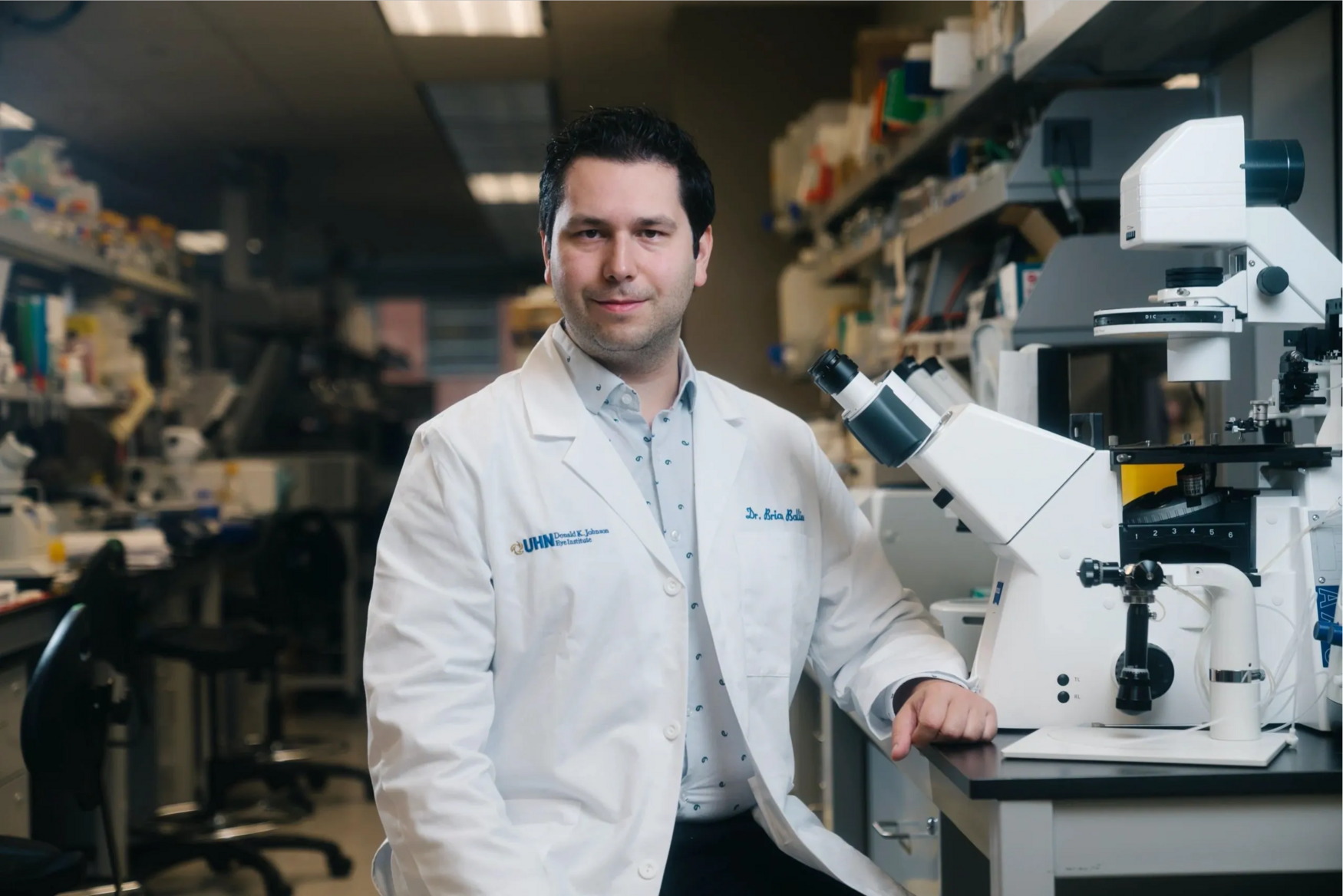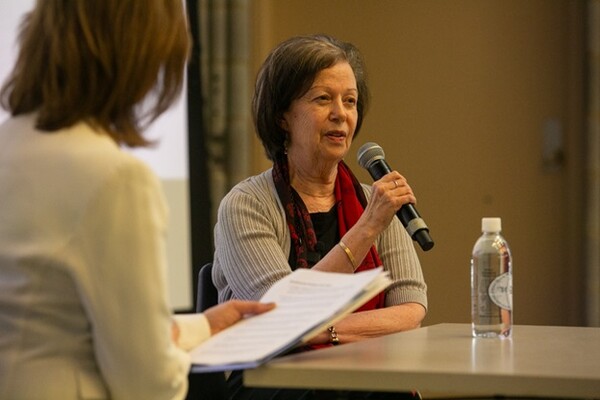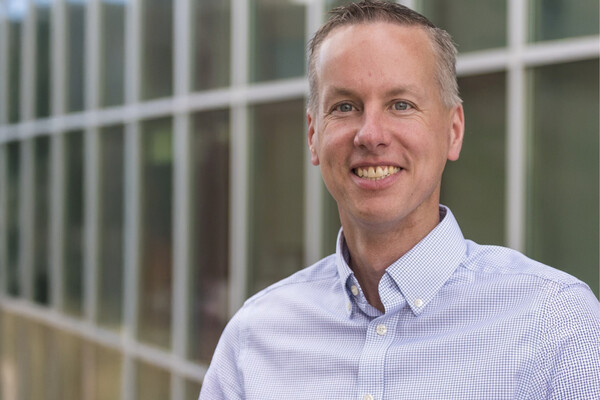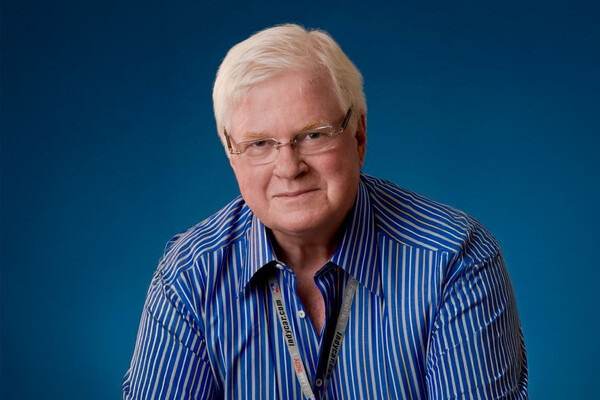Main Second Level Navigation
Breadcrumbs
- Home
- News & Events
- Recent News
- Alumni Profile: Brian Ballios on fighting blindness
Alumni Profile: Brian Ballios on fighting blindness

Brian Ballios (MD/PhD ’15, PGME Ophthalmology ’20) is an assistant professor of ophthalmology at the University of Toronto where he holds the J. Ardeth Hill – Fighting Blindness Canada Professorship in Ocular Genetics Research. He is also a clinician-scientist with the University Health Network (UHN)’s Donald K. Johnson Eye Institute and the Kensington Vision and Research Centre, as well as a staff ophthalmologist at Sunnybrook Health Sciences Centre.
Ballios specializes in retinal disease and ocular genomics. He’s currently pursuing groundbreaking research into treatments for genetic blindness.
We talked to Ballios about his research and vision for the future of retinal disease treatment.
You earned a BSc in engineering chemistry at Queen’s University before entering the MD/PhD Program at U of T’s Temerty Faculty of Medicine — what inspired you to seek a medical education?
As a kid I was always interested in how things worked, and how you could apply science to make things work. Engineering gave me great experience with that, and skills to solve real-world problems using scientific techniques.
During my undergrad, I worked in a bio-engineering lab developing new injectable polymeric biomaterials for drug delivery, and I really liked how it brought together engineering and human health. I remember being at a project meeting concerning a long-release pain management system we were working on, to be implanted under the skin. One of our physician collaborators, an anesthesiologist, was asking questions that demonstrated such a thorough and empathetic understanding of the problem, and great insight into what was needed to improve the solution. Questions like “How thick is the material? How would it feel under the skin?” I thought to myself, “Wouldn’t it be a powerful combination if the person designing the solution really understood the problem from a medical application standpoint?” That was my first inkling that I wanted to become more involved in medicine.
U of T’s MD/PhD program was also an easy decision, because it’s the most prestigious and longest running program of its kind in Canada. It has the most diverse researchers, and an incredible alumni network of physician-scientists who are out there successfully combining clinical medicine and research. It was an obvious first choice.
Why did you choose ophthalmology as your specialty?
When I was starting my PhD, I asked my supervisors Molly Shoichet and Derek van der Kooy what I could do that would be helpful, and a good fit for someone with an engineering background. They steered me towards a project that had recently stalled, trying to fix defective photoreceptor cells in the retina — essentially, fighting genetic blindness.
Using an injectable biomaterial as a conductor, we were able to transplant healthy photoreceptors into the diseased eye of a mouse and restore some vision. That was a very important discovery in the field, because it was the first time anyone had ever used an injectable biomaterial to transplant cells in the eye. It’s been really gratifying to evolve that research over the last decade, to the point that these materials are being used in clinical trials.
So that’s how I became interested in retinal disease, but I came to ophthalmology as a practice through my interactions with patients. People undergoing treatment would come up to me at research conferences wanting to learn more about my work, and consequently I learned a lot about who my research would ultimately benefit. I felt like I could really help these people, and that they needed a lot of help.
We often take our vision for granted. We don’t appreciate it until there’s a problem, and then it quickly becomes the most important problem. It’s a privilege helping people through those problems.
We often take our vision for granted. We don’t appreciate it until there’s a problem, and then it quickly becomes the most important problem.Brian Ballios
You recently completed a fellowship at Harvard (Massachusetts Eye and Ear / Harvard Medical School), what was that experience like?
As an ophthalmology resident you learn a lot about all aspects of eye care. But spending a year immersed in inherited retinal disease research and exclusively treating patients suffering from these diseases was hugely valuable. At Harvard, I participated in clinical trials and research studies where the stem cell and gene therapies I’d been working on in the lab were on their way to becoming a reality.
After I finished that fellowship, I was able to return to U of T and start my own lab and clinical program. My program is unique in that it serves primarily adults. It used to be that once a child or young adult was diagnosed with an inherited retinal disease, it was just a matter of coming to terms with slowly losing sight and managing it. Very few ophthalmologists were focused on fighting this type of blinding eye disease, but now we have treatments that can potentially restore vision.
Your research is currently funded through a donor-supported professorship — how has the position impacted your work?
The J. Ardeth Hill – Fighting Blindness Canada Professorship in Ocular Genetics Research has given me the opportunity to focus specifically on my research, and build on the work I’ve been doing and the skills I’ve been honing for nearly 15 years. I’m able to spend over two-thirds of my time focused on researching new therapies for these diseases and taking deep dives into learning everything I can about them. There’s a lot of demand in Canada for clinicians to support the large number of patients with vision concerns, so you could easily spend all your time focused on those problems right in front of you, and have little time to search for new therapies and longer-term solutions.
What have you seen so far in terms of therapies at work?
We had a man in his mid-20s participate in a gene therapy clinical trial a couple of years ago. He had started to experience some vision loss as a child, and he'd been told then he’d be completely blind by the time he was in his late thirties or forties.
In the weeks that followed his therapy, we watched his field of vision expanding. He could read better. He told us he could find his way around the house with the lights off now. He could identify people from across the street. He could ride his bike through the park and go through shady patches and not worry about falling. He could do all these things he remembered doing as a child but hadn’t been able to do for the last 15 years. That drug is currently finishing phase three clinical trials and we are pushing for public funding to get it into market.
This used to be the stuff of science fiction and now I might be able to write a prescription and help bring sight to someone who never thought they would see again — it’s incredibly exciting.
What is on the horizon for ocular genomics?
Gene therapies are showing themselves to be effective at helping retinas function better and can turn back the clock for some patients, but there are so many others where the disease is too far advanced. That’s where I think stem cell therapies will help — taking tissue that doesn’t work at all and making it work again. There have been promising clinical studies. That’s going to be the big game-changer in the field: the real promise of regenerative medicine.
For me, personally, of course I’m excited to grow my lab and advance these new therapies forward. But as a professor and researcher, it’s also hugely important that I inspire the new generation of students to continue in this field. There is so much opportunity, so much need, and ultimately, so much reward in working to find cures for blinding eye disease.
News


